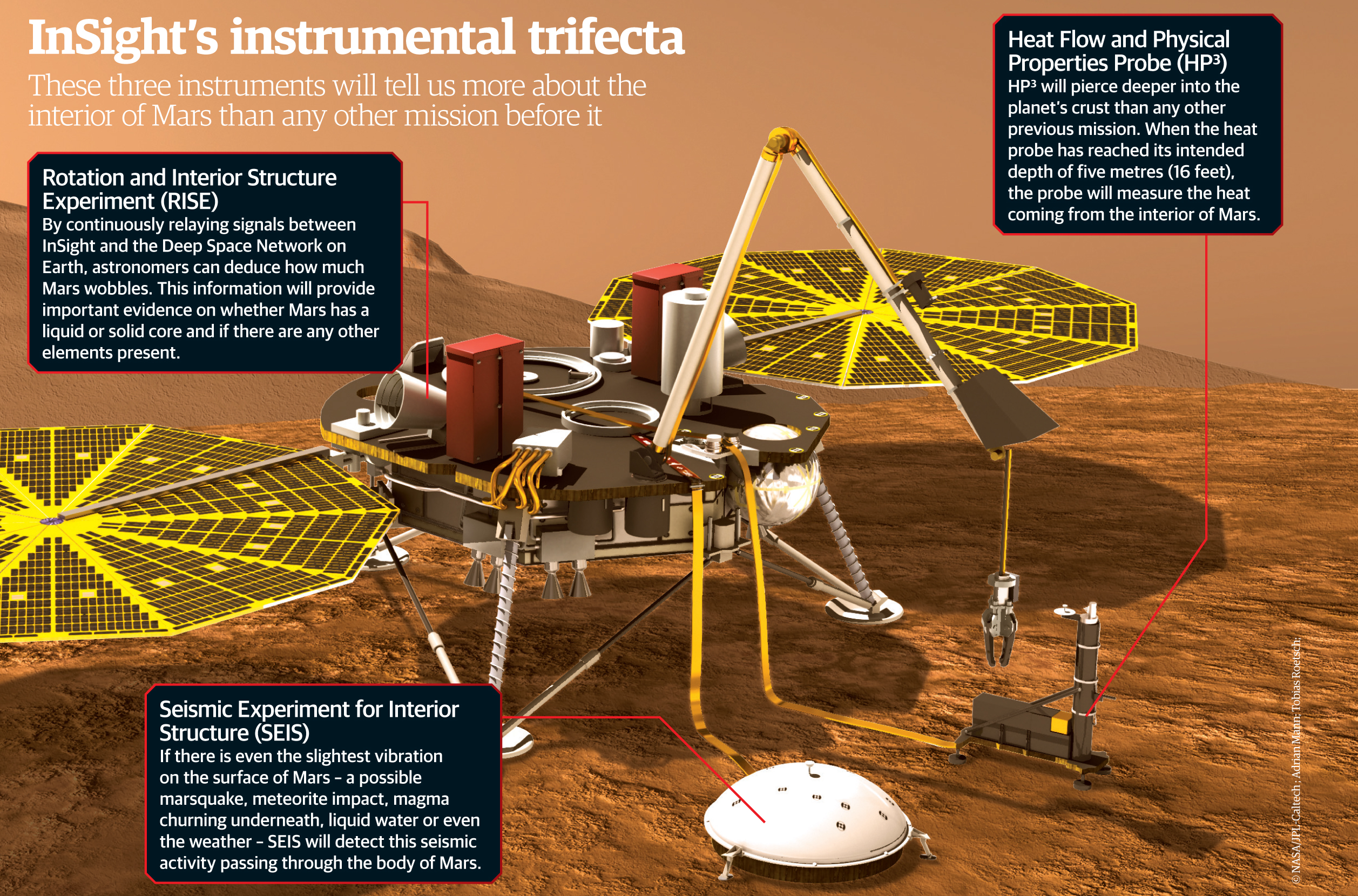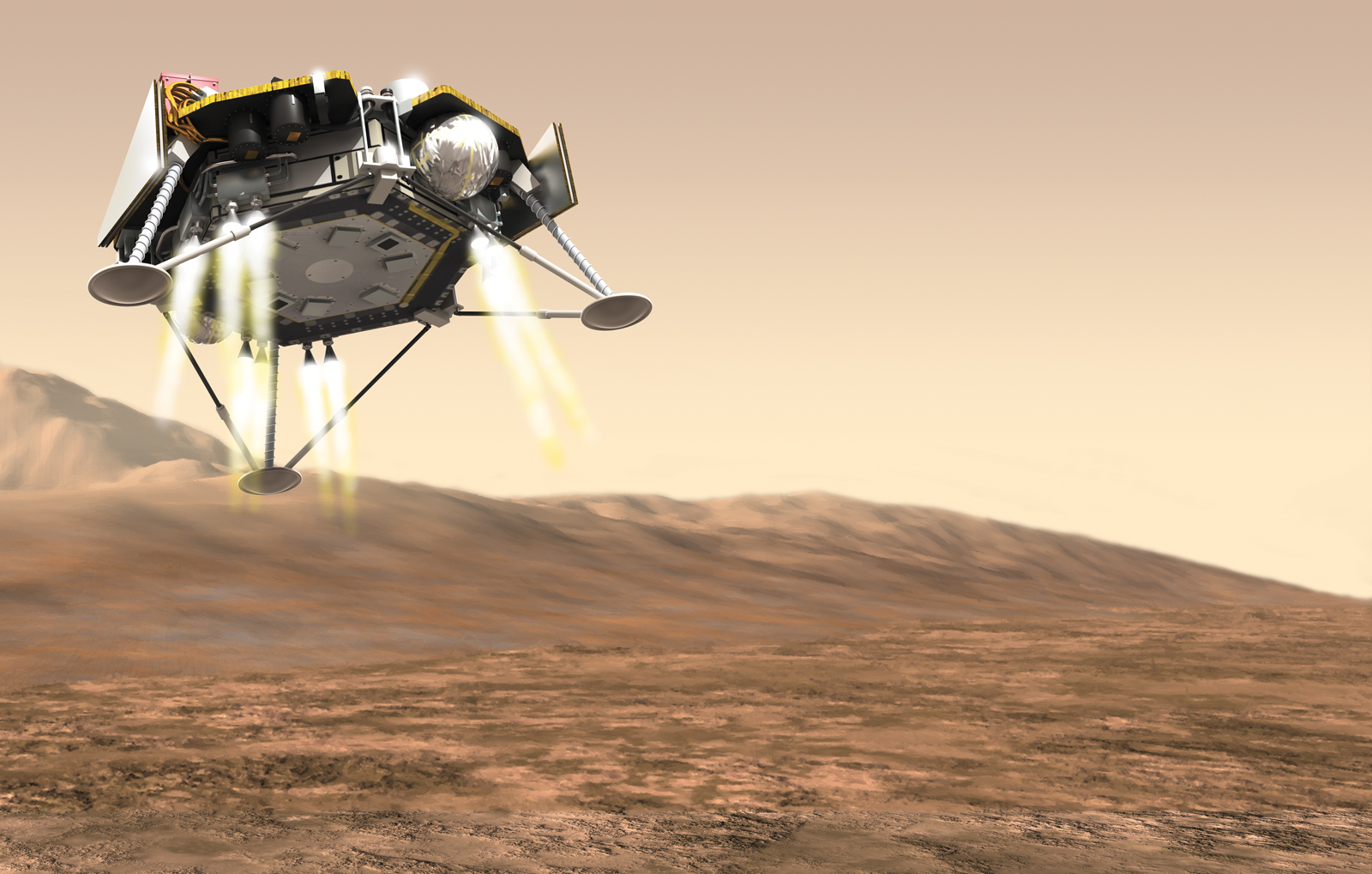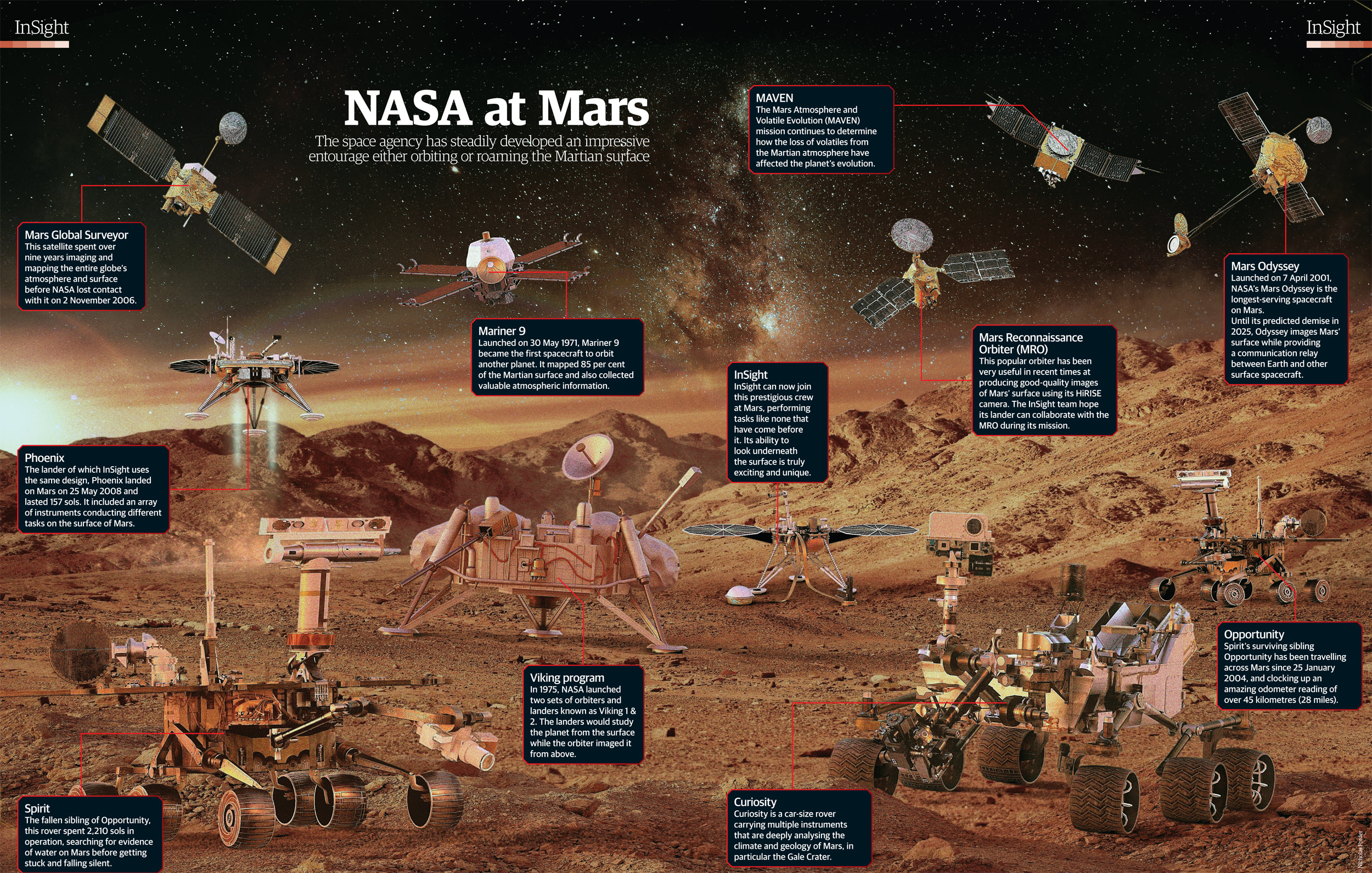Journey to the Center of the Red Planet: NASA's InSight Lander to Reveal the Secrets Inside Mars
Mars is the second-most studied planet — only behind our own — but we know virtually nothing about its interior. All astronomers have to go by is models and theories, but no concrete evidence.
NASA's Interior Exploration using Seismic Investigations, Geodesy and Heat Transport (InSight) mission aims to change that. InSight will touch down Monday (Nov. 26) around 3 p.m. EST (2000 GMT), in a "6 minutes of terror" touchdown that you can follow live here at Space.com. Shortly thereafter, the lander will begin looking beneath the surface of Mars to reveal the secrets within the Red Planet.
About 4.5 billion years ago, the eight planets of our solar system were formed. All eight planets were formed from a clumpy disk of rock, ice and debris orbiting the young sun. Fast-forward to the present and we now see a distinct difference between the inner and outer planets. The terrestrial planets (Mercury, Venus, Earth and Mars) all have a dense, rocky structure, with only one able to support life. The Jovian planets (Jupiter, Saturn, Uranus and Neptune) are all primarily gas and swollen up to enormous sizes. The question that astronomers still can't answer, though, is how did these terrestrial planets form and evolve? [NASA's InSight Mars Lander: Full Coverage]

Thanks to modern technology and perseverance, astronomers have tried to answer this question in a period of extensive exploration of one of our closest neighbors, Mars. However, previous missions have only been able to scratch the surface. Where landers, rovers and orbiters before it have been in hot pursuit of water on the dry, sandy surface, or designed to study the planet's tiny atmosphere, InSight is delving deeper into the unknown. By putting an ear to the ground, astronomers will get a more comprehensive understanding of the Red Planet's core, mantle and crust.
"The objectives of the mission are to map the structure and thermal state of the deep interior of Mars for the first time, and to use this information to better understand the early formation processes of terrestrial planets, including the Earth," InSight principal investigator Bruce Banerdt, of NASA's Jet Propulsion Laboratory (JPL) in Pasadena, California, told All About Space.
Originally due to launch in March 2016, InSight suffered a major setback when a vacuum leak was found in one of the lander's key instruments in December 2015. But mission team members fixed the leak, and InSight launched toward the Red Planet at the next available opportunity, in May 2018. (Mars and Earth align favorably for interplanetary missions every 26 months.)
InSight lifted off atop a United Launch Alliance Atlas V rocket from Vandenberg Air Force Base in California on May 5, becoming the first interplanetary mission ever to launch from the United States' West Coast. InSight and two free-flying cubesats, known as MarCO-A and MarCO-B, then endured a 6.5-month journey toward a planet redder and drier than Earth, and about half our world's size. [Launch Photos: NASA's InSight Mars Lander Blasts Off on Atlas V Rocket]
Breaking space news, the latest updates on rocket launches, skywatching events and more!

From here, InSight can finally join its NASA predecessors as it finds unequivocally important and revolutionary results, if all goes according to plan. (The briefcase-size MarCO-A and MarCO-B have a different fate; the duo's main mission involves showing that cubesats can explore interplanetary space. The pair will attempt to beam home InSight data during the lander's touchdown, but this task is not essential, as NASA Mars orbiters will do this as well. MarCO-A and MarCO-B will zoom past Mars on Monday, and their missions will end shortly thereafter.)
When NASA sent its first successful orbiter in 1971, Mariner 9, it became the first spacecraft to orbit another planet, sending back over 7,300 images of the Martian surface and its two moons. Since then, humans have maintained an impressive number of satellites in orbit and probes on the surface, including the late and great missions such as the Mars Global Surveyor orbiter, the Viking 1 and 2 missions and the Spirit rover.

There are also many functioning visitors still at Mars, including the Curiosity and Opportunity rovers and the Mars Reconnaissance Orbiter (MRO) and Mars Atmosphere and Volatile Evolution Mission (MAVEN). The Phoenix lander, which was launched on Aug. 4, 2007, and lay stationary on the surface for 157 Martian days (also known as sols; one sol is roughly 40 minutes longer than an Earth day), is the mission that InSight's design is based on.
"InSight will use the same lander design as the 2007 Phoenix mission, which gives us a proven landing and surface system without the cost of developing them from scratch," Banerdt explained. "Plus, we will be using several orbiters at Mars to relay back to Earth our precious data. It's hard to overstate the extent that knowledge from earlier missions informs InSight science."
The InSight lander will stand at a height between 33 to 43 inches (83 to 108 centimeters) above the Martian surface, and once InSight's solar panels are deployed, its total span will be 19.7 feet (6 meters). This is roughly equivalent to two-thirds of the length of a London bus. Overall the whole lander will weigh 794 lbs. (360 kilograms), which is about 88 percent of the mass of the Phoenix lander. Packed within this bundle are some of the finest and most sensitive instruments to ever grace the planet's soil, and they are required to function for at least one Martian year, which is roughly equivalent to two Earth years.
Before these instruments can blossom, the InSight lander needs to survive its harrowing entry, descent and landing sequence. In about 6 minutes on Monday, the lander has to go from travelling at 14,100 mph (22,692 km/h) through the atmosphere of Mars, to a dead stop on the surface. As Mars' atmosphere is 100 times thinner than Earth's, slowing down the spacecraft is a much more difficult task. To succeed, a heat shield will cause as much friction with as little atmosphere as possible, causing the shield to reach extreme temperatures. The spacecraft will then deploy its parachute, jettison its heat shield and extend its legs. After bringing the lander to a reasonable descending speed, the parachute is shed and 12 boosters at the bottom of the lander begin firing. This provides the final cushion before it lands in Elysium Planitia. [Mars InSight: NASA's Mission to Probe Red Planet's Core (Gallery)]
When asked about why Elysium Planitia was selected as the designated home for the duration of InSight's mission, Matthew Golombek of JPL, InSight's landing-site lead, told All About Space it's because "it meets all the engineering constraints for landing and surviving for a Mars year. It is low in elevation, near the equator and smooth, flat and relatively rock-free over the landing ellipse."
Once landing is complete and InSight has reached its destination, its solar panels and instruments can be prepared. The blooming of the solar panels is the most essential part of the whole mission, as the lander will be powered by the less intense rays of a farther-away sun. The sun shines roughly half as bright on Mars than Earth, meaning InSight's solar panels need to be able to squeeze as much solar juice out of those rays as possible. Once its solar wings are spread, the instruments can be deployed, and the mysteries of Mars' mischievous mantle and core can be unveiled. The Instrument Deployment Arm (IDA) will place the seismometer, the Seismic Experiment for Interior Structure (SEIS) and the heat flow probe, the Heat Flow and Physical Properties Probe (HP3), on the ground. Along with a radio-science investigation, the Rotation and Interior Structure Experiment (RISE), this tactical trio will be at the forefront of the interior investigations.
Each instrument has been carefully planned and created to perform a very specific task. SEIS will be the first seismometer to Mars in 40 years, and will listen out for tremors that could come from marsquakes, meteorite impacts or even possibly magma churning deep underneath the Red Planet's surface. In fact, this Martian stethoscope is so sensitive it can pick up vibrations smaller than a hydrogen atom.
"SEIS will be placed on the ground by a robotic arm and will 'listen' for the small (fractions of a nanometer) ground vibrations due to seismic waves that have travelled through the planet from distant marsquakes," Banerdt said. "Analysis of these waves will allow us to create a 3D picture of the inside of the planet."
The InSight team also have plans to collaborate with the MRO mission, which will be on the lookout for meteorite impacts. When the seismometer detects a meteoritic impact, MRO and its meticulous High Resolution Imaging Science Experiment (HiRISE) camera will scout out the fresh crater.
Alongside SEIS is a drill that will take the planet's temperature. HP3 will make its way 16 feet (5 m) down into the Martian crust. This is just 10 percent of Mars' overall crust, but it is a good enough depth to allow astronomers to analyze the heat that comes from deep within the planet. The heat flowing underneath the surface reveals how active the planet is. On Earth, we are well aware of a region of magma churning beneath our crust that drives our tectonic plates and heats up our planet. The heat flow within Mars could be compared to Earth's and reveal that both were formed from the same substances, and if they aren't, then why not.
"We're essentially doing the same thing anyone would do on a campout, but we're putting our stake down on Mars," said Suzanne Smrekar of JPL, InSight's deputy principal investigator.
"Getting well below the surface gets us away from the sun's influence and allows us to measure heat coming from the interior," she added. "InSight is going take the heartbeat and vital signs of the Red Planet for an entire Martian year, two Earth years. We are really going to have an opportunity to understand the processes that control the early planetary formation."

This article was provided by Space.com's sister publication All About Space, a print magazine dedicated to astronomy, space exploration and the night sky. Sign up for the All About Space newsletter for news and subscription details! Follow us @Spacedotcom or Facebook. This version of the story published on Space.com.
Join our Space Forums to keep talking space on the latest missions, night sky and more! And if you have a news tip, correction or comment, let us know at: community@space.com.
Lee Cavendish holds a degree in Observational Astronomy from the University of South Wales, United Kingdom, where his research interests focused on studying the main types of eclipsing binary star systems: Algol, Beta Lyrae and W Ursae Majoris. He is the former staff writer for our sister publication All About Space magazine, where he covered everything from the latest space technologies and mission launches to planetary science and complexities of the universe.


